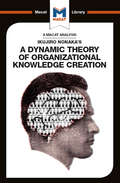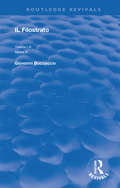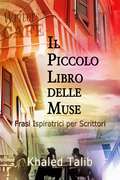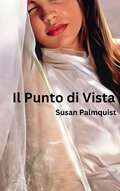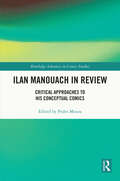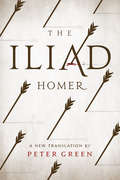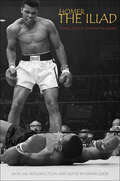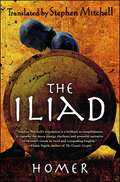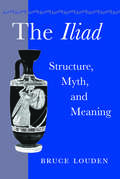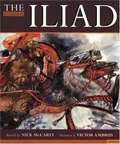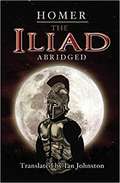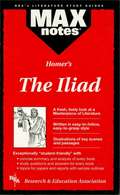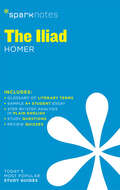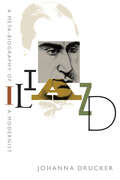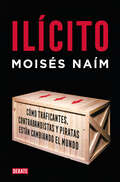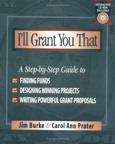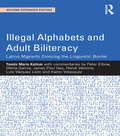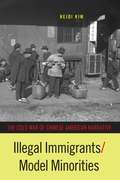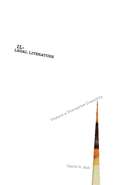- Table View
- List View
Ikujiro Nonaka's A Dynamic Theory of Organisational Knowledge Creation (The Macat Library)
by Stoyan StoyanovIkujiro Nonaka’s A Dynamic Theory of Organisational Knowledge Creation outlines the creation of organisational knowledge through the constant conversion of the two types of knowledge, tacit and explicit, which Nonaka believes has the potential to guide managers’ knowledge creation strategies. This argument is centred on the conviction that companies are not passive parties that simply utilise existing knowledge for providing solutions to the customers, and that organisations and environments simultaneously influence knowledge creation. This text is considered fundamental for the knowledge management field and as such, it has been utilised by a large number of academics.
Il Filostrato: Poema (1789) (Routledge Revivals)
by Giovanni BoccaccioOriginally published in 1986, this translated version of Giovanni Boccaccio's Il Filostrato is of particular interest as the principal source for Chaucer's great work, the Troilus. This edition includes the original Italian alongside the translation, so that even the English reader with no knowledge of Italian will be able to make out a good deal of the original assisted by a close translation.
Il Piccolo Libro delle Muse: Frasi Ispiratrici per Scrittori
by Khaled Talib AndreaIl Piccolo Libro delle Muse è una raccolta di frasi personali che si propone di aiutare gli scrittori e gli aspiranti autori a trovare e conservare la gioia di scrivere.
Il Punto di Vista: Scrittura creativa facile
by Susan PalmquistI tuoi racconti e romanzi vengono rifiutati dagli editori e non ti spieghi il perché? Ti viene detto spesso che pecchi di intrusione dell’autore o che la tua storia manca di emozione? Il tuo manoscritto è stato rifiutato per problemi di head-hopping? Scrittura creativa facile – Il Punto di Vista ti aiuta a dare forza alla tua storia e a eliminare gli errori che ti fanno apparire uno scrittore principiante, e ti suggerisce dei pratici modi per agganciare il lettore a ciascun personaggio da te creato. Cosa imparerai Le differenze tra raccontare in prima e in terza persona, e come sono collegate al Punto di Vista. Come capire quale PdV è quello giusto per la tua storia. Un modo facile per individuare gli errori di head-hopping nella tua storia, e un modo facile per evitarlo. Il PdV profondo e quali vantaggi comporta usarlo. I capitoli sono brevi e di facile lettura, ognuno corredato da un esercizio specifico, Fai pratica.
Il Teatro di Eduardo de Filippo: La Crisi della Famiglia Patriarcale
by Donatella Fischer"Eduardo De Filippo (1900-1984) e uno dei maggiori drammaturghi del novecento. Nel suo teatro, la famiglia rappresenta il punto nevralgico della societa. Attraverso quest'unita archetipica, le opere qui considerate si propongono come un lungo esame dei rapporti familiari e sono, al contempo, il barometro dei mutamenti sociali e culturali delle diverse epoche in cui si svolge l'azione. In questo nuovo lavoro, Donatella Fischer analizza ogni commedia come un ulteriore passo verso l'inarrestabile frantumazione dell'universo familiare e, soprattutto, della famiglia patriarcale i cui precetti si rivelano sempre piu anacronistici. Eduardo De Filippo ritrae famiglie divise dal conflitto fra illusione e realta (Natale in casa Cupiello), aggrappate alla speranza (Napoli Milionaria! e Questi fantasmi!), sovversive dietro la cornice borghese (Filumena Marturano), in balia del proprio tempo (Mia famiglia) e ridotte infine all'involucro di se stesse nell'ultima opera dell'autoreGli esami non finiscono mai."
Ilan Manouach in Review: Critical Approaches to his Conceptual Comics (Routledge Advances in Comics Studies)
by Pedro MouraThis book takes an interdisciplinary and diverse critical look at the work of comic artist Ilan Manouach, situating it within the avant-garde movement more broadly. An international team of authors engages with the topic from diverse theoretical approaches, from traditional narratology and aesthetic close readings of some of Manouach's books, engaging with comics' own distinctive history, modes of production, circulation and reception, to perspectives from disability studies, post-colonial studies, technological criticism, media ecology, ontography, posthumanist philosophy, and issues of materiality and media specificity. This innovative and timely volume will interest students and scholars of comic studies, media studies, media ecology, literature, cultural studies, and visual studies.
The Iliad: A New Translation by Peter Green
by HomerOne of the oldest extant works of Western literature, the Iliad is a timeless epic poem of great warriors trapped between their own heroic pride and the arbitrary, often vicious decisions of fate and the gods. Renowned scholar and acclaimed translator Peter Green captures the Iliad in all its surging thunder for a new generation of readers. Featuring an enticingly personal introduction, a detailed synopsis of each book, a wide-ranging glossary, and explanatory notes for the few puzzling in-text items, the book also includes a select bibliography for those who want to learn more about Homer and the Greek epic. This landmark translation--specifically designed, like the oral original, to be read aloud--will soon be required reading for every student of Greek antiquity, and the great traditions of history and literature to which it gave birth.
The Iliad (Johns Hopkins New Translations from Antiquity)
by HomerEdward McCrorie offers a new verse translation of the Iliad, capturing the meaning and music of Homer's original Greek.Sing of rage, Goddess, that bane of Akhilleus,Peleus' son, which caused untold pain for Akhaians,sent down throngs of powerful spirits to Aides, war-chiefs rendered the prize of dogs and everysort of bird.Edward McCrorie’s new translation of Homer’s classic epic of the Trojan War captures the falling rhythms of a doomed Troy. McCrorie presents the sundry epithets and resonant symbols of Homer's verse style and remains as close to the Greek's meaning as research allows. The work is an epic with a flexible contemporary feel to it, capturing the wide-ranging tempos of the original. It underscores the honor of soldiers and dwells upon the machinations of Moira, each man's and woman's portion in life.Noted Homeric scholar Erwin Cook contributes a substantial introduction and extensive notes written to guide both students and general readers through relevant elements of ancient Greek history and culture. This version of the Iliad is ideal for readings and performances.
The Iliad: (The Stephen Mitchell Translation)
by Homer Stephen MitchellTOLSTOY CALLED THE ILIAD A miracle; Goethe said that it always thrust him into a state of astonishment. Homer’s story is thrilling, and his Greek is perhaps the most beautiful poetry ever sung or written. But until now, even the best English translations haven’t been able to re-create the energy and simplicity, the speed, grace, and pulsing rhythm of the original. In Stephen Mitchell’s Iliad, the epic story resounds again across 2,700 years, as if the lifeblood of its heroes Achilles and Patroclus, Hector and Priam flows in every word. And we are there with them, amid the horror and ecstasy of war, carried along by a poetry that lifts even the most devastating human events into the realm of the beautiful. Mitchell’s Iliad is the first translation based on the work of the preeminent Homeric scholar Martin L. West, whose edition of the original Greek identifies many passages that were added after the Iliad was first written down, to the detriment of the music and the story. Omitting these hundreds of interpolated lines restores a dramatically sharper, leaner text. In addition, Mitchell’s illuminating introduction opens the epic still further to our understanding and appreciation. Now, thanks to Stephen Mitchell’s scholarship and the power of his language, the Iliad’s ancient story comes to moving, vivid new life.
The Iliad: a commentary
by G. S. KirkThis, the fourth volume in the six-volume Commentary on The Iliad being prepared under the General Editorship of Professor G. S. Kirk, covers Books 13-16, including the Battle for the Ships, the Deception of Zeus and the Death of Patroklos. Three introductory essays discuss the role of Homer's gods in his poetry; the origins and development of the epic diction; and the transmission of the text, from the bard's lips to our own manuscripts. It is now widely recognised that the first masterpiece of Western literature is an oral poem; Professor Janko's detailed commentary aims to show how this recognition can clarify many linguistic and textual problems, entailing a radical reassessment of the work of Homer's Alexandrian editors. The commentary also explores the poet's subtle creativity in adapting traditional materials, whether formulae, typical scenes, mythology or imagery, so as best to move, inspire and entertain his audience, ancient and modern alike. Discussion of the poem's literary qualities and structure is, where possible, kept separate from that of more technical matters.
The Iliad: Structure, Myth, and Meaning
by Bruce LoudenExtending his distinctive analysis of Homeric epic to the Iliad, Bruce Louden, author of The "Odyssey": Structure, Narration, and Meaning, again presents new approaches to understanding the themes and story of the poem. In this thought-provoking study, he demonstrates how repeated narrative motifs argue for an expanded understanding of the structure of epic poetry. First identifying the "subgenres" of myth within the poem, he then reads these against related mythologies of the Near East, developing a context in which the poem can be more accurately interpreted.Louden begins by focusing on the ways in which the Iliad's three movements correspond with and comment on each other. He offers original interpretations of many episodes, notably in books 3 and 7, and makes new arguments about some well-known controversies (e.g., the duals in book 9), the Iliad's use of parody, the function of theomachy, and the prefiguring of Hektor as a sacrificial victim in books 3 and 6. The second part of the book compares fourteen subgenres of myth in the Iliad to contemporaneous Near Eastern traditions such as those of the Old Testament and of Ugaritic mythology. Louden concludes with an extended comparison of the Homeric Athena and Anat, a West Semitic goddess worshipped by the Phoenicians and Egyptians. Louden's innovative method yields striking new insights into the formation and early literary contexts of Greek epic poetry.
The Iliad
by Nick Mccarty Victor G. AmbrusVivid illustrations by noted artist Victor Ambrus brings to life this new retelling of Paris' doomed love for Helen and the years of siege that roiled the ancient city of Troy. [Proofreader's Notes: Illustrations are not described as they add nothing to the text story. There is a "Glossary of Main Characters" at the end of the book, naming and describing their inter-relationships. This might be helpful to read before the story.
The Iliad: Translated By Ian Johnston
by Ian Johnston HomerHomer's Iliad, the oldest and greatest epic poem in our culture, was composed in the eighth century BC. It became the single most important literary resource in ancient Greek culture, and has exercised a decisive influence on Western culture an influence which continues to this day. The poem tells the story of a quarrel between Achilles, the greatest of the Achaean warriors in the Greek expedition against Troy, and Agamemnon, the commander of the expedition an argument which causes Achilles to withdraw from the fighting. The battles continue without him, and the ironic unfolding of events eventually leads him to rejoin the war and to seek out the great Trojan warrior Hector for a climactic single combat. The Iliad is our most important war poem. It constantly forces us to confront what goes on in battle, how men sustain themselves amid the horrors of the killing zone, and how the activity is simultaneous intensely and brutally destructive and also, by one of the strangest of all of life's ironies, intensely creative. Ian Johnston's abridged version of Homer's great poem is based upon his acclaimed translation of the complete epic (also published by Richer Resources Publications). The abridged text is approximately one third of the original and presents a coherent narrative poem in which every line is taken from Homer's text, with occasional short summaries to keep the story coherent. This shortened version is an ideal entry into Homer's vision of the world for those who are not yet ready or do not have the time to tackle the full poem. The text is accompanied by a few explanatory footnotes, a glossary of names, and a map indicating the origin of many of the major characters.
The Iliad (MAXNotes Literature Guides)
by Beth TanisREA's MAXnotes for Homer's The Illiad MAXnotes offer a fresh look at masterpieces of literature, presented in a lively and interesting fashion. Written by literary experts who currently teach the subject, MAXnotes will enhance your understanding and enjoyment of the work. MAXnotes are designed to stimulate independent thought about the literary work by raising various issues and thought-provoking ideas and questions. MAXnotes cover the essentials of what one should know about each work, including an overall summary, character lists, an explanation and discussion of the plot, the work's historical context, illustrations to convey the mood of the work, and a biography of the author. Each chapter is individually summarized and analyzed, and has study questions and answers.
The Iliad SparkNotes Literature Guide (SparkNotes Literature Guide Series #35)
by SparkNotesThe Iliad SparkNotes Literature Guide by Homer Making the reading experience fun! When a paper is due, and dreaded exams loom, here's the lit-crit help students need to succeed! SparkNotes Literature Guides make studying smarter, better, and faster. They provide chapter-by-chapter analysis; explanations of key themes, motifs, and symbols; a review quiz; and essay topics. Lively and accessible, SparkNotes is perfect for late-night studying and paper writing. Includes:An A+ Essay—an actual literary essay written about the Spark-ed book—to show students how a paper should be written.16 pages devoted to writing a literary essay including: a glossary of literary termsStep-by-step tutoring on how to write a literary essayA feature on how not to plagiarize
Iliazd: A Meta-Biography of a Modernist (Hopkins Studies in Modernism)
by Johanna DruckerA captivating portrait of futurist artist Iliazd infused with the reflections of his accidental biographer on the stickiness of the genre.The poet Ilia Zdanevich, known in his professional life as Iliazd, began his career in the pre-Revolutionary artistic circles of Russian futurism. By the end of his life, he was the publisher of deluxe limited edition books in Paris. The recent subject of major exhibitions in Moscow, his native Tbilisi, New York, and other venues, the work of Iliazd has been prized by bibliophiles and collectors for its exquisite book design and innovative typography. Iliazd collaborated with many major figures of modern art—Pablo Picasso, Sonia Delaunay, Max Ernst, Joán Miro, Natalia Goncharova, and Mikhail Larionov, among others. His 1949 anthology, The Poetry of Unknown Words, was the first international anthology of experimental visual and sound poetry ever published. The list of contributors is a veritable "Who's Who" of avant-garde writing and visual art. And Iliazd's unique hands-on engagement with book production and design makes him the ideal case study for considering the book as a modern art form. Iliazd is the first full-length biography of the poet-publisher, as well as the first comprehensive English-language study of his life and work. Johanna Drucker weaves two stories together: the history of Iliazd's work as a modern artist and poet, and the narrative of the author's encounter with his widow and other figures in the process of researching his biography. Drucker's reflection on what a biographical project entails addresses questions about the relationship between documentary evidence and narrative, between contemporary witnesses and retrospective accounts. Ultimately, Drucker asks how we should understand the connection between the life of an artist and their work. Enriched with photographs from the Iliazd archive and a wealth of primary documents, the book is a vivid account of a unique contributor to modernism—and to the way we continue to reevaluate the history of twentieth-century culture. Accounts of Drucker's research during the mid-1980s in the personal archive of Madame Hélène Zdanevich, the poet's widow, lend the narrative an incredible intimacy. Drucker recounts how, sitting in the studio that Iliazd occupied from the late 1930s until his death in 1975, she was drawn into the circle of scholars who had made him their focus and were doing foundational work on his significance. She also coped with the difference between the widow's view of the artist as a man she loved and Drucker's own perception of Iliazd's significance within a critical approach to history. Iliazd is at once a rich study of a significant figure and a thoughtful reflection on the way a biography creates an encounter with its always absent subject.
Ilícito: Cómo traficantes, contrabandistas y piratas están cambiando el mundo
by Moisés NaímCómo los traficantes están cambiando el mundo. Siempre han existido contrabandistas, traficantes y piratas, pero nunca como hoy, con la capacidad de operar a nivel mundial conectando los lugares más remotos del planeta y las capitales más cosmopolitas a la velocidad de Internet o de sus jets privados, con un poder económico que mueve más del 10 por ciento del comercio mundial (diez veces más que hace una década), y sobre todo con el poder político que han acumulado en todo el mundo. Nunca antes los criminales habían sido tan globales, tan ricos ni tan políticamente influyentes. Moisés Naím expone en este libro la contundente tesis de que los traficantes están cambiando el mundo. El autor, director de la influyente revista Foreign Policy y uno de los analistas más prestigiosos del mundo, desvela por qué ningún gobierno ha podido contener el crecimiento de este comercio ilícito, llevando al lector a mundos inexploradosque muestran gráficamente las fuerzas tecnológicas, económicas, sociales, culturales y políticas que dan forma a este siglo XXI. ¿Por qué ha aumentado de forma espectacular el comercio ilícito de armas, órganos humanos, drogas, falsificaciones de lujo y personas? ¿Cómo se explica que el vendedor ambulante de imitaciones de Gucci sea él mismo tan ilegal como su mercancía? ¿Cómo se conectan las redes de tráfico humano con las de relojes copiados o bufandas de Hermès pirateadas? Escrito con gran pulso narrativo, el resultado es una obra llena de datos sorprendentes y nombres propios, un panorama mundial casi desconocido, que nos permite comprender cómo el incesante aumento del comercio ilícito internacional no solo altera la economía mundial, sino que afecta a los gobiernos y socava las bases mismas de nuestro modo de vida.
I'll Be Your Mirror: The Selected Andy Warhol Interviews
by Kenneth GoldsmithThe Question-and-Answer interview was one of Andy WarholOCOs favorite communication vehicles, so much so that he named his own magazine after the form. Yet, never before has anyone published a collection of interviews that Warhol himself gave. IOCOll Be Your Mirror contains more then thirty conversations revealing this unique and important artist. Each piece presents a different facet of the Sphinx-like WarholOCOs ever-evolving personality. Writer Kenneth Goldsmith provides context and provenance for each selection. Beginning in 1962 with a notorious interview in which Warhol literally begs the interviewer to put words into his mouth, the book covers WarholOCOs most important artistic period during the OCO60s. As Warhol shifts to filmmaking in the OCO70s, this collection explores his emergence as socialite, scene-maker, and trendsetter; his influential Interview magazine; and the Studio 54 scene. In the 80s, his support of young artists like Jean-Michel Basquait, his perspective on art history and the growing relationship to technology in his work are shown. Finally, his return to religious imagery and spirituality are available in an interview conducted just months before his death. Including photographs and previous unpublished interviews, this collage of Warhol showcases the artistOCOs ability to manipulate, captivate, and enrich American culture. "
I'll Grant You That: A Step-by-Step Guide to Finding Funds, Designing Winning Projects, and Writing Powerful Grant Proposals
by Jim Burke Carol Ann PraterI'll Grant You That is an all-in-one resource for finding funds, designing winning projects, and writing powerful proposals.
I'll Teach my Dog 100 Words (Bright & Early Book, A #No. 17)
by Michael Frith"I'll Teach My Dog 100 Words" shows young children how easy it is to learn to read - even for a dog. The words in red are easily identified as the 'taught' words which cover basic concepts like colours and opposites - and of course, counting to 100. <P><P>"Bright and Early" books help even the youngest child get ready to read. Simple stories and basic concepts are humorously presented in rhythm and rhyme. Pictures that fully explain the text help even babies make the important connection between word and meaning. It's never too early to find out that 'Learning to read is fun'.
Illegal Alphabets and Adult Biliteracy: Latino Migrants Crossing the Linguistic Border, Expanded Edition
by Tomás Mario KalmarHow do "illegal aliens" chart the speech sounds of colloquial English? This book is timeless in offering an unusually direct entry into how a group of Mexican fruit pickers analyze their first encounter with local American speech in a tiny rural Midwestern community in the United States. Readers see close up how intelligently migrant workers help each other use what they already know—the alphabetic principle of one letter, one sound—to teach each other, from scratch, at the very first contact, a language which none of them can speak. They see how and why the strategies adult immigrants actually use in order to cope with English in the real world seem to have little in common with those used in publicly funded bilingual and ESL classrooms. What’s new in this expanded edition of Tomás Mario Kalmar’s landmark Illegal Alphabets and Adult Biliteracy are in-depth commentaries from six distinguished scholars—Peter Elbow, Ofelia García, James Paul Gee, Hervé Varenne, Luis Vázquez León, Karen Velasquez—who bring to it their own personal, professional, and (multi)disciplinary viewpoints.
Illegal Immigrants/Model Minorities: The Cold War of Chinese American Narrative (Asian American History & Cultu #225)
by Heidi KimIn the Cold War era, Chinese Americans were caught in a double-bind. The widespread stigma of illegal immigration, as it was often called, was most easily countered with the model minority, assimilating and forming nuclear families, but that in turn led to further stereotypes. In Illegal Immigrants/Model Minorities, Heidi Kim investigates how Chinese American writers navigated a strategy to normalize and justify the Chinese presence during a time when fears of Communism ran high. Kim explores how writers like Maxine Hong Kingston, Jade Snow Wong, and C. Y. Lee, among others, addressed issues of history, family, blood purity, and law through then-groundbreaking novels and memoirs. Illegal Immigrants/Model Minorities also uses legal cases, immigration documents, and law as well as mass media coverage to illustrate how writers constructed stories in relation to the political structures that allowed or disallowed their presence, their citizenship, and their blended identity. Kim illuminates the rapidly shifting political and social pressures on Chinese American authors who selectively concealed, revealed, and reconstructed issues of citizenship, belonging, and inclusion in their writing.
Illegal Immigrants/Model Minorities: The Cold War of Chinese American Narrative (Asian American History & Cultu #225)
by Heidi KimIn the Cold War era, Chinese Americans were caught in a double-bind. The widespread stigma of illegal immigration, as it was often called, was most easily countered with the model minority, assimilating and forming nuclear families, but that in turn led to further stereotypes. In Illegal Immigrants/Model Minorities, Heidi Kim investigates how Chinese American writers navigated a strategy to normalize and justify the Chinese presence during a time when fears of Communism ran high. Kim explores how writers like Maxine Hong Kingston, Jade Snow Wong, and C. Y. Lee, among others, addressed issues of history, family, blood purity, and law through then-groundbreaking novels and memoirs. Illegal Immigrants/Model Minorities also uses legal cases, immigration documents, and law as well as mass media coverage to illustrate how writers constructed stories in relation to the political structures that allowed or disallowed their presence, their citizenship, and their blended identity. Kim illuminates the rapidly shifting political and social pressures on Chinese American authors who selectively concealed, revealed, and reconstructed issues of citizenship, belonging, and inclusion in their writing.
Illegal Literature: Toward a Disruptive Creativity
by David S. RohWhat is the cultural value of illegal works that violate the copyrights of popular fiction? Why do they persist despite clear and stringent intellectual property laws? Drawing on the disciplines of new media, law, and literary studies, Illegal Literature suggests that extralegal works such as fan fiction are critical to a system that spurs the evolution of culture.Reconsidering voices relegated to the cultural periphery, David S. Roh shows how infrastructure—in the form of legal policy and network distribution—slows or accelerates the rate of change. He analyzes the relationship between intellectual property rights and American literature in two recent copyright disputes. And, in comparing American fan fiction and Japanese dojinshi, he illustrates how infrastructure and legal climates detract from or encourage fledgling creativity.Illegal Literature fills a crucial gap between the scholarly and the popular by closely examining several modes of marginalized cultural production. Roh makes the case for protecting an environment conducive to literary heresy, the articulation of an accretive rather than solitary authorial genius, and the idea that letting go rather than holding on is important to a generative creative process. In a media ecology inundated by unauthorized materials, Illegal Literature argues that the proliferation of unsanctioned texts may actually benefit literary and cultural development.
